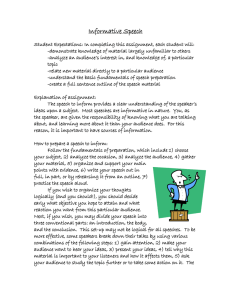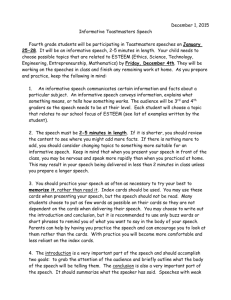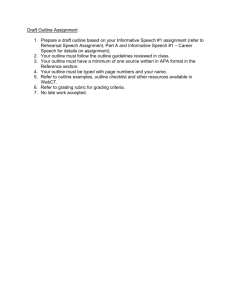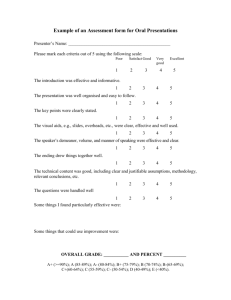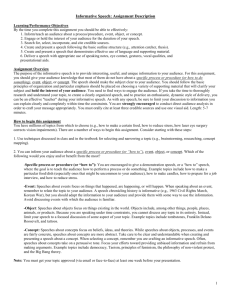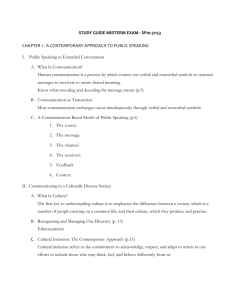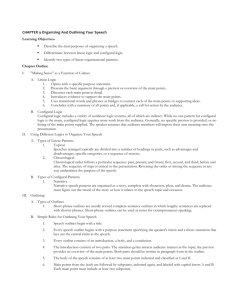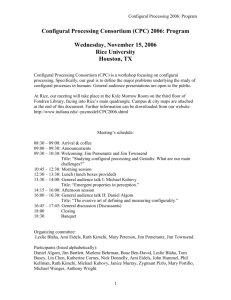study guide midterm exam -‐ sp10-‐50545 chapter 1
advertisement
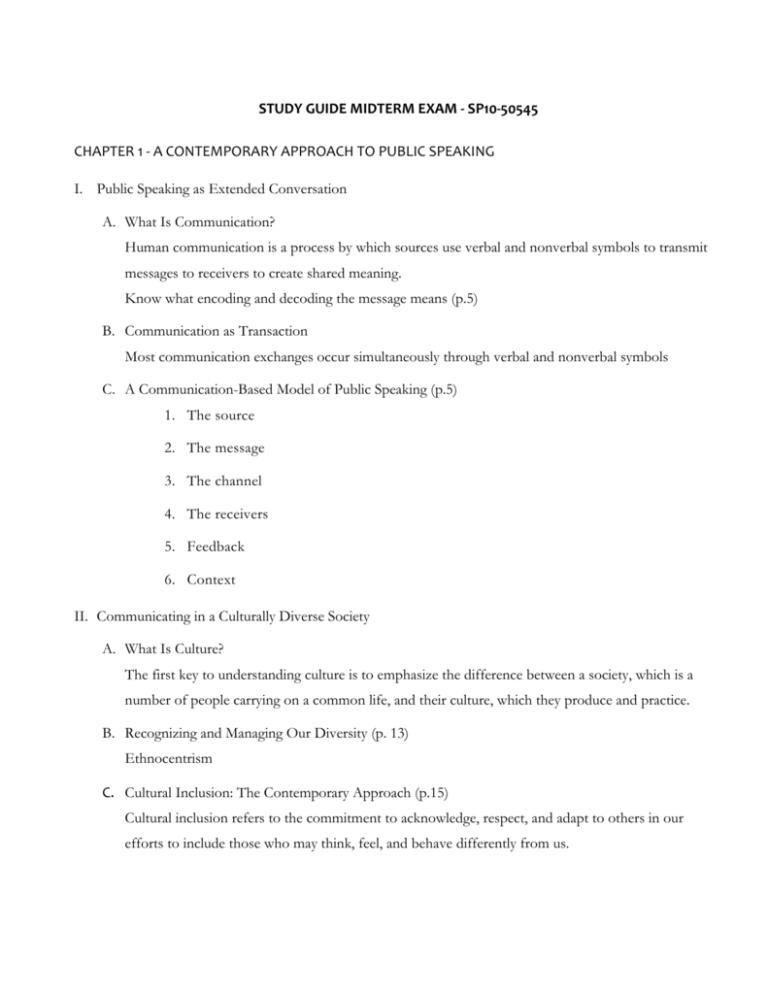
STUDY GUIDE MIDTERM EXAM -­‐ SP10-­‐50545 CHAPTER 1 -­‐ A CONTEMPORARY APPROACH TO PUBLIC SPEAKING I. Public Speaking as Extended Conversation A. What Is Communication? Human communication is a process by which sources use verbal and nonverbal symbols to transmit messages to receivers to create shared meaning. Know what encoding and decoding the message means (p.5) B. Communication as Transaction Most communication exchanges occur simultaneously through verbal and nonverbal symbols C. A Communication-Based Model of Public Speaking (p.5) 1. The source 2. The message 3. The channel 4. The receivers 5. Feedback 6. Context II. Communicating in a Culturally Diverse Society A. What Is Culture? The first key to understanding culture is to emphasize the difference between a society, which is a number of people carrying on a common life, and their culture, which they produce and practice. B. Recognizing and Managing Our Diversity (p. 13) Ethnocentrism C. Cultural Inclusion: The Contemporary Approach (p.15) Cultural inclusion refers to the commitment to acknowledge, respect, and adapt to others in our efforts to include those who may think, feel, and behave differently from us. CHAPTER 3-­‐THE INFLUENCE OF CULTURE ON PUBLIC SPEAKING I. The Influence of Culture on Communication (p.34) In this book, intercultural communication is defined as message exchange between co-cultural backgrounds distinct enough to change the event. A. Cultural Features That Make a Difference 1. High and low context (p.36) 2. High and low power distance (p.37) Power is distributed differently among different cultures. Some cultures minimize power and status differences; others place a high value on social, birth order, or occupational status and political rankings. CHAPTER 6-­‐ ANALYZING AND ADAPTING TO DIVERSE AUDIENCES I. Analyzing Your Audience Audience analysis is the systematic gathering of information about an audience in an effort to learn everything possible about it that is relevant to the topic. A. Audience Demographics (p. 95) Demographic makeup refers to the social characteristics of the audience. Analysis by social categories (e.g., gender, age, and religion) can reveal beliefs and orientations that audience members are likely to share and that are likely to affect how they will respond to a particular topic, an approach to that topic, and a particular speaking style. B. Audience Psychographics Audience psychographics seek to determine what kinds of attitudes, beliefs, and opinions people share. A psychographic audience analysis includes the audience's motives for being in the audience; its interests in and knowledge of the speaker's topic; and the audience members' personal feelings. CHAPTER 8-­‐ SELECTING AND RESEARCHING YOUR TOPIC I. Selecting a Topic A. Specifying Your Purpose (pp. 135-136) Specify the purpose of the presentation by telling the audience that it is meant to inform, entertain, or persuade. B. Formulating a Thesis Statement II. Researching Your Topic A. Types of Support 1. Eyewitness accounts, stories, and quotable phrases Audiences are more likely to agree with a speaker who demonstrates a personal connection with the speech topic. B. Evaluating Sources from the Internet 1. Relevancy (p.147) The degree of association between the reference and the topic 2. Recency 3. Credibility Evidence consistent with other known facts or data CHAPTER 9 -­‐ ORGANIZING AND OUTLINING YOUR SPEECH (p. 152) I. "Making Sense" as a Function of Culture What may seem organized and coherent to individuals in one co-culture may appear disorganized to another. A. Linear Logic A speech organized in a linear fashion leads the audience through ordered steps. B. Configural Logic (p. 156-157) Configural logic includes a variety of nonlinear logic systems, all of which are indirect. II. Using Different Logics to Organize Your Speech A. Types of Linear Patterns (p. 159-160) 1. Speeches arranged topically are divided into a number of headings or parts, such as advantages and disadvantages, specific categories, or a sequence of reasons. 2. Chronological order follows a particular sequence: past, present, and future; first, second, and third; before and after. B. Types of Configural Patterns (p.161) 1. Narrative speech patterns are organized as a story, complete with characters, plots, and drama. III. Outlining (p. 166-7) A. Simple Rules for Outlining Your Speech 1. Every speech outline begins with a purpose statement specifying the speaker's intent and a thesis statement that lays out the central claim in the speech. 2. Main points from the body are followed by subpoints, indented again, and labeled with capital letters A and B. Each main point must include at least two subpoints. 3. The conclusion follows the body of the speech and consists of two parts: a summary and a memorable closing statement. 4. Every outline ends with a reference list. CHAPTER 11-­‐ Speaking To Inform I. Goals and Types of Informative Speeches A. Goals of Informative Speaking (p.192)) Be able to distinguish between informative and persuasive speaking. Types of Informative Speeches 1. Lectures provide new or additional information about a particular subject; audience members are usually referred to as students. 2. Demonstrations are a short how-to speech explaining a particular activity or use a specific object. II. Organizing and Outlining an Informative Speech (p.195) A. The introduction should compel the audience to listen with an attention-getter. B. The body of the informative speech should contain no more than three main points, organized in a way that helps the audience make sense of the message. (p. 196) III. Strategies for Increasing Informational Effectiveness A. Keep It Simple (p. 200) The fewer points the speech presents, the more likely the audience will learn them. Too many numbers or statistics bore the audience. B. Be Repetitive and Redundant Repetition refers to explaining something exactly the same way over and over again. Redundancy involves explaining something more than once, but in a slightly different way each time. C. Use Transitions and Signposts Signposts are simple words or phrases that signal organization.
